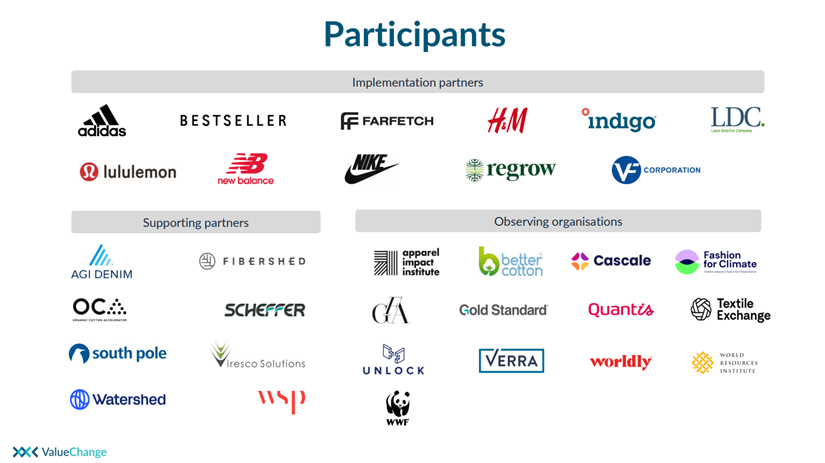The first Value Chain Intervention Guidance for the Apparel and Footwear sector
Dino De Francesco
The Value Change Initiative has just published the first Apparel & Footwear Value Chain Intervention Guidance. This sector-specific addendum to the VCI Guidance 1.1 (2021) provides a common reference for credible implementation, accounting, reporting, and claiming of Interventions. It builds on the GHG Protocol’s Corporate Value Chain (Scope 3) Accounting and Reporting Standard, while bringing the focus on the implementation level to provide practical solutions for reporting companies.
The guidance is shaped on the consensus of 32 organisations who participated in the second VCI Apparel & Footwear Working Group in 2023. The guidance explores scenarios and best practices on how to strike the right balance between scalability and credibility to obtain a wide buy-in from value chain actors and unlock action, with the aim to reach 45% emission reductions in the Apparel & Footwear sector by 2030.

What does the guidance cover?
The focus of the Apparel & Footwear Value Chain Intervention Guidance is Scope 3, Category 1: Purchased goods and services, since around 80% of Scope 3 emissions in the sector are from this category.
The guidance presents for the first time a commonly agreed understanding of the key challenges that hinder the decarbonisation of the sector. Identifying what the main hurdles are and building consensus around their definition are key steps as we continue to work towards collaborative solutions. Some of the challenges identified in the guidance include lack of clear industry guidelines, lack of alignment on fundamental concepts, and limited access to high quality data.
The guidance also proposes archetypes of interventions for Tier 1-3 (manufacturing processes) and Tier 4 (raw materials). Tier 1-3 interventions, such as energy processes and low-impact technologies, generally have relatively high traceability but present problems in impact allocation and attribution, while Tier 4 interventions are often agriculture projects which tend to have imperfect traceability or limitations with data availability. The archetypes presented in the guidance enable a consistent approach across actors and reduce the complexity of Scope 3 interventions.
Finally, the guidance explores scenarios for the identified interventions to incentivise participation and investment. Scenarios explore how accounting, reporting and claiming of interventions can be done while following current guidance, leveraging the Supply Shed concept to address imperfect traceability, proposing new lines of reporting for transparency and much more.
How will the guidance help companies on the ground?
The guidance was officially launched at an online event during which guest speakers from Textile Exchange, adidas, Bestseller and Apparel Impact Institute shared how they see the role of this guidance in practice.
“Based on the modelling we have done to understand the greenhouse gas emissions associated with the initial production of fibres and raw materials used in the global fashion, apparel, and textile industry, we are not on track to achieve our 45% emission reduction target by 2030,” shared Beth Jensen from Textile Exchange. “This guidance helps the industry reference a shared language and align on potential ways forward for different types of interventions that can be taken to accelerate our collective efforts to achieve this target.”
Speakers agreed that there is a need for increased alignment across standards and methods in the sector. “There’s considerable room for interpretation on existing accounting rules in the industry. We need to align on what we should or shouldn’t be doing,” said Jesus Aisa from adidas. “Emission reduction projects are challenging, so we need to move as an industry when exploring options.”
Cecilia Wörlén from Bestseller also added that future regulation also makes accounting and reporting increasingly important for companies. “The Corporate Sustainability Reporting Directive (CSRD) requires companies to verify GHG data in the EU. As accounting professionals, we need to be able to defend our calculations to auditors, and this guidance is the first step in documenting the commonly agreed best practice.”
It is also important for the industry to create incentives for companies and suppliers to take action. Ryan Gaines from Apparel Impact Institute highlighted the key role of the guidance for this. “We need a huge level of finance to achieve our emission reduction targets. The guidance contributes to identifying the financial incentives for companies to invest and receive impact attributes to use in their reporting, while also incentivising suppliers to implement interventions.”
Jesus Aisa further shared that this guidance enables businesses to have confidence in their actions. “Having this guidance as a reference point helps us understand whether we’re going in the right direction.”
What’s next for value chain decarbonisation in the Apparel & Footwear sector?
The guidance recommends companies in the Apparel & Footwear sector to focus on the following areas of work:
- Enhancing inter-tier reporting and claiming across the value chain.
- Rethinking the role of suppliers in the decarbonisation transition, ensuring they are not unfairly burdened with the highest risk.
- Developing infrastructure that incentivises credible action towards sustainability through impact attribution.
- Aligning frameworks for a holistic assessment of different environmental dimensions across the value chain.
The VCI will continue this work through its next Apparel & Footwear Working Group, launching in April 2024. We invite companies in the sector to engage in the discussion and make use of the guidance when planning and executing decarbonisation interventions in their value chains. To join the upcoming Apparel & Footwear work, get in touch with our team.
Ready to decarbonise your value chains?
Download the Apparel & Footwear Value Chain Intervention Guidance to learn best practice on how to account, report and claim your value chain emission reductions.

